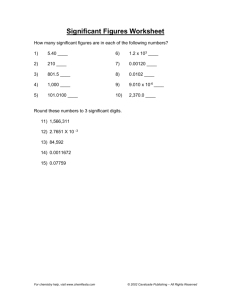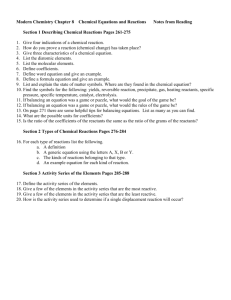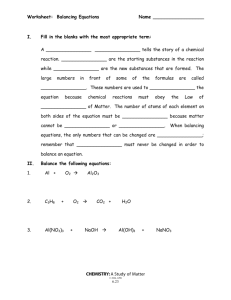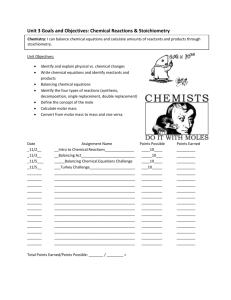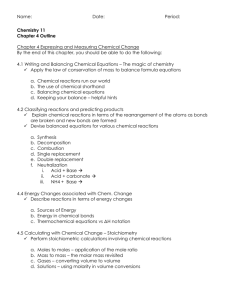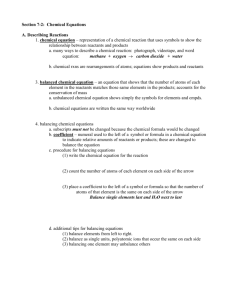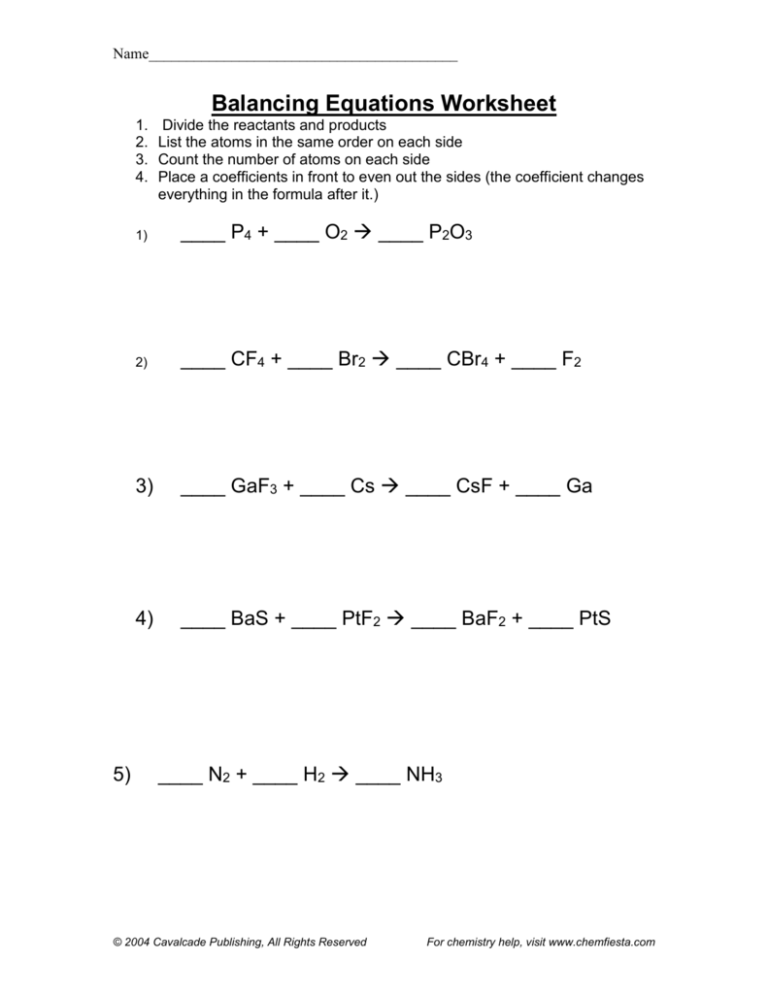
Name_________________________________________
Balancing Equations Worksheet
1.
2.
3.
4.
5)
Divide the reactants and products
List the atoms in the same order on each side
Count the number of atoms on each side
Place a coefficients in front to even out the sides (the coefficient changes
everything in the formula after it.)
1)
____ P4 + ____ O2 ____ P2O3
2)
____ CF4 + ____ Br2 ____ CBr4 + ____ F2
3)
____ GaF3 + ____ Cs ____ CsF + ____ Ga
4)
____ BaS + ____ PtF2 ____ BaF2 + ____ PtS
____ N2 + ____ H2 ____ NH3
© 2004 Cavalcade Publishing, All Rights Reserved
For chemistry help, visit www.chemfiesta.com
Name_________________________________________
6)____ NaF + ____ Br2 ____ NaBr + ____ F2
7)
____ CH4 + ____ O2 ____ CO2 + ____ H2O
8)
____ K + ____ Cl2 ____ KCl
9)
____ Al + ____ HCl ____ H2 + ____ AlCl3
10) ____ N2 + ____ F2 ____ NF3
© 2004 Cavalcade Publishing, All Rights Reserved
For chemistry help, visit www.chemfiesta.com
Name_________________________________________
Balancing Equations Worksheet – Answers
Note to students: It is acceptable to leave spaces blank when balancing
equations – blank spaces are interpreted as containing the number “1”.
1)
1 Na3PO4 + 3 KOH 3 NaOH + 1 K3PO4
2)
1 MgF2 + 1 Li2CO3 1 MgCO3 + 2 LiF
3)
1 P4 + 3 O2 2 P2O3
4)
2 RbNO3 + 1 BeF2 1 Be(NO3)2 + 2 RbF
5)
2 AgNO3 + 1 Cu 1 Cu(NO3)2 + 2 Ag
6)
1 CF4 + 2 Br2 1 CBr4 + 2 F2
7)
2 HCN + 1 CuSO4 1 H2SO4 + 1 Cu(CN)2
8)
1 GaF3 + 3 Cs 3 CsF + 1 Ga
9)
1 BaS + 1 PtF2 1 BaF2 + 1 PtS
10)
1 N2 + 3 H2 2 NH3
11)
2 NaF + 1 Br2 2 NaBr + 1 F2
12)
1 Pb(OH)2 + 2 HCl 2 H2O + 1 PbCl2
13)
2 AlBr3 + 3 K2SO4 6 KBr + 1 Al2(SO4)3
14)
1 CH4 + 2 O2 1 CO2 + 2 H2O
15)
2 Na3PO4 + 3 CaCl2 6 NaCl + 1 Ca3(PO4)2
16)
2 K + 1 Cl2 2 KCl
17)
2 Al + 6 HCl 3 H2 + 2 AlCl3
18)
1 N2 + 3 F2 2 NF3
19)
1 SO2 + 2 Li2Se 1 SSe2 + 2 Li2O
20)
2 NH3 + 1 H2SO4 1 (NH4)2SO4
© 2004 Cavalcade Publishing, All Rights Reserved
For chemistry help, visit www.chemfiesta.com
Name_________________________________________
Balancing Chemical Equations
Products
coefficients
Subscripts
gas
equation
reactants
mass
A chemical _____________ describes what happens in a chemical
reaction. The equation identifies the ___________________ (starting
materials) and ________________ (resulting substance), the formulas
of the participants, the phases of the participants (solid, liquid,
____________), and the amount of each substance. Balancing a
chemical equation refers to establishing the mathematical relationship
between the quantity of reactants and products. The quantities are
expressed as grams or moles.
It takes practice to be able to write balanced equations. There are
essentially three steps to the process:
1. Write the unbalanced equation.
Chemical formulas of reactants are listed on the lefthand side
of the equation.
Products are listed on the righthand side of the equation.
Reactants and products are separated by putting an arrow
between them to show the direction of the reaction. Reactions
at equilibrium will have arrows facing both directions.
2. Balance the equation.
Apply the Law of Conservation of ______ to get the same
number of atoms of every element on each side of the
equation. Tip: Start by balancing an element that appears in
only one reactant and product.
Once one element is balanced, proceed to balance another, and
another, until all elements are balanced.
Balance chemical formulas by placing
______________________ in front of them. Do not
add____________________, because this will change the
formulas.
© 2004 Cavalcade Publishing, All Rights Reserved
For chemistry help, visit www.chemfiesta.com
Name_________________________________________
Balancing equations with Polyatomic Ions
PO4 – phosphate
OH-hydroxide
CO3-carbonate
NO3-nitrate
SO4-sulfate
1)
____ Na3PO4 + ____ KOH ____ NaOH + ____ K3PO4
2)
____ MgF2 + ____ Li2CO3 ____ MgCO3 + ____ LiF
3)
____ RbNO3 + ____ BeF2 ____ Be(NO3)2 + ____ RbF
4)
____ AgNO3 + ____ Cu ____ Cu(NO3)2 + ____ Ag
5)
____ HCN + ____ CuSO4 ____ H2SO4 + ____ Cu(CN)2
6)
____ Pb(OH)2 + ____ HCl ____ H2O + ____ PbCl2
© 2004 Cavalcade Publishing, All Rights Reserved
For chemistry help, visit www.chemfiesta.com
Name_________________________________________
7)
____ AlBr3 + ____ K2SO4 ____ KBr + ____ Al2(SO4)3
8)
____ Na3PO4 + ____ CaCl2 ____ NaCl + ____ Ca3(PO4)2
9)
____ SO2 + ____ Li2Se ____ SSe2 + ____ Li2O
10)
____ NH3 + ____ H2SO4 ____ (NH4)2SO4
© 2004 Cavalcade Publishing, All Rights Reserved
For chemistry help, visit www.chemfiesta.com

